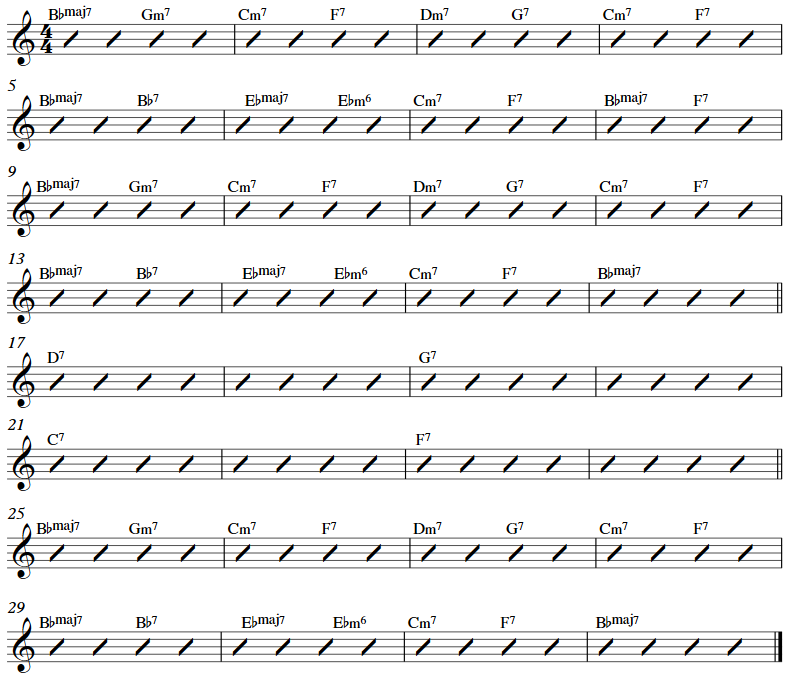In this article I’ll present 3 tips for playing “Rhythm Changes.” What are “rhythm changes,” you ask? The expression “rhythm changes” in jazz-speak refers to the chord changes that were used in Gershwin’s classic Broadway hit “I Got Rhythm.” The catchy, jazzy chord progression has been used by many other jazz artists who write their own melody over the same set of chords, resulting in a large number of what are referred to as “rhythm changes tunes.” Notable songs using this chord progression include:
- Oleo
- The Flintstones theme
- Anthropology
- Rhythm-A-Ning
- Cotton Tail
- Moose the Mooche
For this reason, knowing the chord progression from “I Got Rhythm” is an important area of study for all jazz musicians and is a topic that contains a wealth of harmonic information and possibilities. The tips presented here are meant to help jazz musicians develop improvisation ideas, as well as comping ideas for pianists and chordal players.
“Rhythm Changes” Tip #1: Memorize the Form.
Ok, this might seem like kind of an obvious tip but it’s incredibly important and therefore needs to be included here. Check out the lead sheet below showing just the chord changes before reading on.

A few things to consider that will help you memorize this form quickly:
- It’s very repetitive. The form is an ‘AABA’ form, meaning that measures 1-8 are the same as measures 9-16 and measures 25-32. Memorize those 8 measures and you’ve memorized 75% of the tune. The bridge (measures 17-24) consists of only 4 chords.
- The chord progression for much of the ‘A’ section is based on a I-vi-ii-V progression, one of the most common progressions in jazz music. The chords on the bridge are a sequence of dominant chords moving down in 5ths.
- Lastly, the chords are largely diatonic (at least in the ‘A’ section). This means that most of the ‘A’ section chords are built around one key, or tonal center (Bb major in the example shown above).
“Rhythm Changes” Tip #2: Turn the bridge into a series of ii-V progressions.
Instead of simply playing the bridge as two measures of one chord, practice inserting the “ii” of each “V” chord in the first of the two measures. For example, instead of playing (two measures each) D7, G7, C7, F7 try playing (one measure each) Am7 – D7, Dm7 – G7, Gm7 – C7, Cm7 – F7.

While approaching the bridge this way doesn’t really change the chords or the harmonic progression, it does give you more options for comping and soloing.
Rhythm Changes Tip #3: Try some chord substitution using chromatic motion.
This is a fancy way of saying that we can slightly re-write the chords in a way that creates half-step (i.e., chromatic) motion in the chords and bass line. Let’s take measures 1-4 of the ‘A’ section. Check out what we can do to the chords:

How are we able to do this? Let’s talk through the chord substitutions above.
- In measure 1 we have our original Bb major chord and then a G7/B chord. Why this chord? The G7 chord pulls us to its ‘I’ chord, which in this instance is the C minor chord in measure 2. We use this inversion (G7/B) as a way of moving the bass tones of the chord up in half-steps (i.e., chromatic motion).
- In measure 2 we have the original C minor chord. The C# diminished chord also functions like a dominant chord pulling us to its “I” chord. This one is tricky to see however. The C# diminished 7th chord has many of the same chord tones as an A7 (b9) chord – C#, E, G, Bb and A, C#, E, G, Bb respectively. In that way, the C# diminished chord resolves to the D minor chord in measure 3.
- In measure 3 we have the original D minor chord and the Db7 chord is simply a tritone substitution of the original G7 chord. The same kind of tritone substitution is at work in measure 4, the B7 in place of the original F7 chord.

